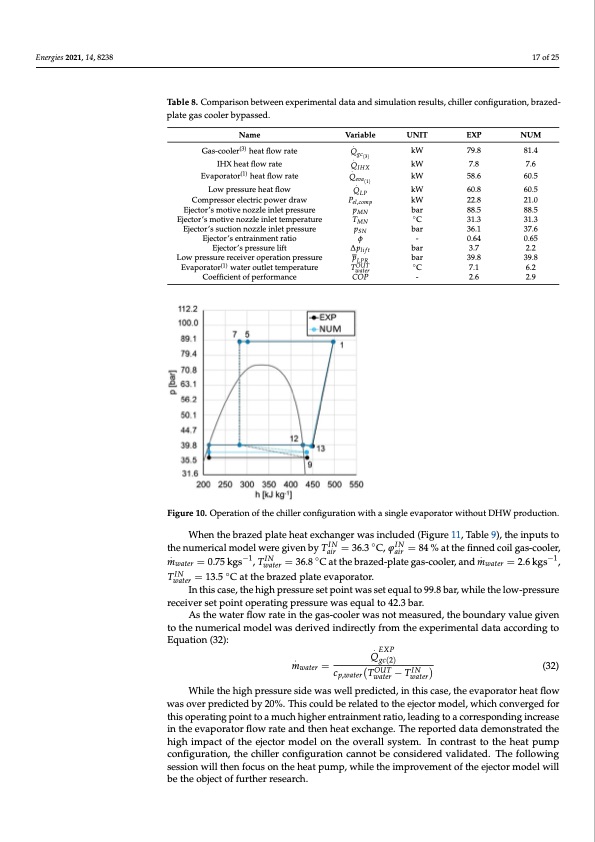
PDF Publication Title:
Text from PDF Page: 017
Energies 2021, 14, 8238 17 of 25 Table 8. Comparison between experimental data and simulation results, chiller configuration, brazed- plate gas cooler bypassed. Name Gas-cooler(3) heat flow rate IHX heat flow rate Evaporator(1) heat flow rate Low pressure heat flow Compressor electric power draw Ejector ’s motive nozzle inlet pressure Ejector’s motive nozzle inlet temperature Ejector’s suction nozzle inlet pressure Ejector’s entrainment ratio Ejector’s pressure lift Low pressure receiver operation pressure Evaporator(1) water outlet temperature Coefficient of performance Variable UNIT EXP NUM Q. kW 79.8 81.4 . gc(3) QIHX kW 7.8 7.6 Q. kW 58.6 60.5 eva(1) . QLP kW 60.8 60.5 Pel,comp kW 22.8 21.0 p M N bar 88.5 88.5 TMN ◦C 31.3 31.3 pSN bar 36.1 37.6 φ - 0.64 0.65 ∆pli f t bar 3.7 2.2 pLPR bar 39.8 39.8 TOUT ◦C 7.1 6.2 water COP - 2.6 2.9 Figure 10. Operation of the chiller configuration with a single evaporator without DHW production. When the brazed plate heat exchanger was included (Figure 11, Table 9), the inputs to the numerical model were given by TIN = 36.3 ◦C, φIN = 84 % at the finned coil gas-cooler, . −1IN ◦air air . −1 mwater = 0.75 kgs , Twater = 36.8 C at the brazed-plate gas-cooler, and mwater = 2.6 kgs , TIN = 13.5 ◦C at the brazed plate evaporator. water In this case, the high pressure set point was set equal to 99.8 bar, while the low-pressure receiver set point operating pressure was equal to 42.3 bar. As the water flow rate in the gas-cooler was not measured, the boundary value given to the numerical model was derived indirectly from the experimental data according to Equation (32): While the high pressure side was well predicted, in this case, the evaporator heat flow was over predicted by 20%. This could be related to the ejector model, which converged for this operating point to a much higher entrainment ratio, leading to a corresponding increase in the evaporator flow rate and then heat exchange. The reported data demonstrated the high impact of the ejector model on the overall system. In contrast to the heat pump configuration, the chiller configuration cannot be considered validated. The following session will then focus on the heat pump, while the improvement of the ejector model will be the object of further research. . EXP . Qgc(2) mwater = cp,waterTOUT − TIN (32) water waterPDF Image | Dynamic Modelling and Validation of an Air-to-Water Reversible R744

PDF Search Title:
Dynamic Modelling and Validation of an Air-to-Water Reversible R744Original File Name Searched:
Artuso2021dma_publisert.pdfDIY PDF Search: Google It | Yahoo | Bing
CO2 Organic Rankine Cycle Experimenter Platform The supercritical CO2 phase change system is both a heat pump and organic rankine cycle which can be used for those purposes and as a supercritical extractor for advanced subcritical and supercritical extraction technology. Uses include producing nanoparticles, precious metal CO2 extraction, lithium battery recycling, and other applications... More Info
Heat Pumps CO2 ORC Heat Pump System Platform More Info
| CONTACT TEL: 608-238-6001 Email: greg@infinityturbine.com | RSS | AMP |